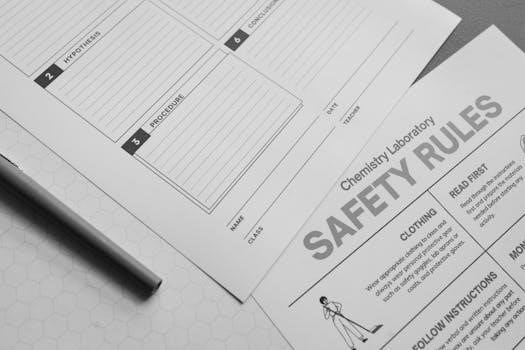GCSE Chemistry Revision Notes PDF⁚ A Comprehensive Guide
Ace your GCSE Chemistry exams with our comprehensive PDF revision notes! Created by experienced educators and examiners, our notes cover all major topics, ensuring you’re well-prepared. Download now and boost your grade!
Understanding the GCSE Chemistry Curriculum

The GCSE Chemistry curriculum, crucial for your success, covers a wide range of topics designed to provide a strong foundation in chemical principles. Mastering this curriculum is essential for achieving top grades and pursuing further studies in science. Key areas include atomic structure, bonding, chemical reactions, and the properties of matter. Understanding these core concepts will enable you to tackle complex problems and excel in your exams. AQA, Edexcel, and OCR are the main exam boards, each with slightly different specifications. Ensure you are familiar with the specific content outlined by your chosen exam board. Effective revision requires a structured approach, focusing on understanding rather than rote memorization. Utilize resources such as revision guides, past papers, and online platforms to reinforce your learning. Pay close attention to the practical aspects of the curriculum, as experimental skills are often assessed. Regular practice and consistent effort will lead to a deeper understanding and improved performance. Remember to break down complex topics into smaller, manageable sections. Use flashcards, mind maps, and other revision techniques to aid recall. Collaborate with classmates and teachers to clarify any doubts or difficulties. By thoroughly understanding the GCSE Chemistry curriculum, you will be well-equipped to succeed in your exams and beyond. Stay organized, stay focused, and believe in your ability to achieve your goals!

Effective Revision Strategies for GCSE Chemistry
To excel in GCSE Chemistry, employing effective revision strategies is paramount. Start by creating a structured revision timetable, allocating specific time slots for each topic. Consistency is key; regular, shorter study sessions are more beneficial than infrequent, lengthy ones. Active recall is a powerful technique⁚ test yourself frequently on key concepts and definitions. Use flashcards to memorize important facts and equations. Practice past papers to familiarize yourself with the exam format and question types. Identify your weaknesses and focus on those areas. Utilize online resources like Seneca and Bitesize for interactive learning and revision materials. Consider using revision guides from Collins or Save My Exams for concise summaries and examiner tips. Mind mapping can help you visualize connections between different topics. Collaborate with classmates to discuss challenging concepts and share revision notes. Ensure you understand the underlying principles rather than simply memorizing facts. Pay attention to practical experiments and their applications. Break down complex topics into smaller, manageable chunks. Use mnemonic devices to aid recall of difficult information. Regularly review your progress and adjust your revision plan accordingly. Don’t underestimate the importance of self-care⁚ get enough sleep, eat healthy, and take breaks to avoid burnout. Stay motivated by setting realistic goals and rewarding yourself for achieving them. With the right strategies and consistent effort, you can achieve your desired grade in GCSE Chemistry. Believe in yourself and stay focused on your goals!
Key Topics in GCSE Chemistry
GCSE Chemistry encompasses a wide range of fundamental topics essential for understanding the world around us. Mastering these key areas is crucial for exam success. One of the foundational topics is atomic structure, which delves into the composition of atoms, including protons, neutrons, and electrons, and how these particles determine an element’s properties. The periodic table is another vital area, exploring the arrangement of elements based on their atomic number and properties, and how their position predicts their reactivity. Bonding and structure examines the different types of chemical bonds – ionic, covalent, and metallic – and how these bonds influence the physical and chemical properties of substances. Chemical reactions are a central theme, covering topics such as balancing equations, rates of reaction, and factors affecting equilibrium. Acids, bases, and salts explore their properties, reactions, and uses. Electrolysis investigates the process of using electricity to decompose compounds. Organic chemistry introduces the study of carbon compounds, including hydrocarbons, alcohols, and carboxylic acids. Quantitative chemistry focuses on calculations involving moles, masses, and concentrations. Qualitative chemistry involves identifying unknown substances through various tests and observations. The Earth and its atmosphere covers topics such as the composition of the atmosphere, climate change, and the use of resources. Understanding these key topics thoroughly will provide a solid foundation for further studies in chemistry and related fields. Make sure to utilize revision resources, practice questions, and past papers to consolidate your knowledge and prepare for the GCSE Chemistry exams. Remember to focus on understanding the underlying concepts rather than simply memorizing facts.

Utilizing Revision Resources⁚ Notes, Flashcards and Past Papers
Effective revision for GCSE Chemistry requires a strategic approach, and leveraging a variety of resources is key to success. Revision notes form the backbone of your study plan, providing concise summaries of key concepts and definitions. Look for well-structured notes that cover the entire syllabus, breaking down complex topics into manageable chunks. Many excellent revision notes are available online, often in PDF format for easy access and printing. These notes should be regularly reviewed and updated as you progress through your studies. Flashcards are a fantastic tool for memorizing key facts, definitions, and equations. Create flashcards for important terms, chemical symbols, and reaction mechanisms. Use them for regular self-testing to reinforce your understanding. You can create your own flashcards or use pre-made sets available online or through revision guides. Past papers are arguably the most valuable revision resource. They provide invaluable practice in answering exam-style questions and familiarizing yourself with the format and structure of the exam. Work through as many past papers as possible, paying close attention to the mark schemes to understand how marks are awarded. Analyze your performance on past papers to identify areas where you need to improve. In addition to these core resources, consider using textbooks, revision guides, online quizzes, and videos to supplement your learning. Experiment with different resources to find what works best for you. Remember to stay organized, create a revision timetable, and prioritize topics based on their importance and your understanding of them. Consistent effort and effective use of revision resources will significantly enhance your chances of success in your GCSE Chemistry exams. Don’t be afraid to seek help from teachers or classmates if you encounter difficulties.
Exam Board Specific Resources (AQA, Edexcel, OCR)
When preparing for your GCSE Chemistry exams, it’s absolutely crucial to utilize resources tailored specifically to your exam board. The three main exam boards in the UK are AQA, Edexcel, and OCR, and each has its own unique syllabus, assessment style, and emphasis. Using generic revision materials can be helpful, but they won’t provide the focused preparation you need to excel. For AQA students, the AQA website is the primary source for specifications, past papers, and examiner reports. Numerous online resources, revision guides, and textbooks are specifically designed for the AQA GCSE Chemistry syllabus. Look for materials that explicitly state they are AQA-approved or aligned with the AQA specification. Edexcel students should consult the Edexcel website for official resources, including the specification, sample assessment materials, and past papers. Edexcel also provides a range of endorsed textbooks and revision guides. Be sure to check that the resources you are using are up-to-date with the latest Edexcel specification. OCR students should refer to the OCR website for the GCSE Chemistry specification, past papers, and other support materials. OCR offers two GCSE Chemistry qualifications⁚ Gateway Science and Twenty First Century Science. Ensure that you are using resources relevant to the specific OCR qualification you are taking. When using past papers, pay close attention to the mark schemes provided by each exam board. These mark schemes will show you exactly how marks are awarded and what examiners are looking for in your answers. Examiner reports are also valuable resources, providing insights into common mistakes made by students and advice on how to improve your exam technique. By focusing on exam board-specific resources, you can ensure that you are studying the correct content, practicing the appropriate question types, and understanding the assessment criteria used by your exam board. This targeted approach will significantly increase your confidence and your chances of achieving a high grade in your GCSE Chemistry exams.
Online Revision Platforms and Tools
In today’s digital age, a wealth of online revision platforms and tools are available to help you succeed in your GCSE Chemistry exams. These resources offer interactive learning experiences, personalized feedback, and convenient access to a vast amount of information. Seneca Learning is a popular platform that provides free, online revision courses for various GCSE Chemistry specifications. Seneca’s courses cover topics such as atomic structure, energy changes, and organic chemistry, and incorporate spaced repetition and active recall techniques to enhance learning. Save My Exams offers comprehensive GCSE Chemistry revision notes, illustrations, and examiner tips. Their resources are created by experienced educators and examiners who actually mark GCSE exams, ensuring that you’re learning exactly what you need to know. BBC Bitesize is a well-known resource that offers easy-to-understand homework and revision materials for GCSE Chemistry. Bitesize covers a wide range of topics and includes videos, quizzes, and interactive activities. Quizlet is a versatile tool that allows you to create and use flashcards, games, and other study activities. You can find pre-made GCSE Chemistry flashcards or create your own to suit your specific needs. MME (Maths Made Easy) provides GCSE Chemistry revision cards that cover all the major topics within the AQA GCSE Chemistry specification. The profits from these cards are reinvested into creating free content on MME. Revisely offers an AI Flashcard Generator that can automatically transform your notes or textbook into flashcards. This can be a great way to quickly create study materials from your existing resources. YouTube channels like Free Science Lessons offer comprehensive GCSE Chemistry revision videos that break down complex concepts into easy-to-understand segments. When using online revision platforms and tools, it’s important to choose resources that are aligned with your exam board’s specification. Look for platforms that offer personalized feedback and track your progress. Remember to use these tools as part of a balanced revision strategy that also includes textbooks, past papers, and practice questions. By leveraging the power of online revision platforms and tools, you can make your GCSE Chemistry revision more effective, engaging, and enjoyable.

Tips for Exam Success in GCSE Chemistry
Excelling in your GCSE Chemistry exams requires a combination of effective revision strategies, a strong understanding of key concepts, and smart exam techniques. Here are some crucial tips to help you achieve success⁚ Master the Fundamentals⁚ Ensure you have a solid grasp of the core concepts and definitions in each topic. This foundation is essential for tackling more complex questions. Utilize revision notes, textbooks, and online resources to solidify your understanding. Practice, Practice, Practice⁚ Regularly attempt past papers and practice questions to familiarize yourself with the exam format, question types, and marking schemes. This will also help you identify your strengths and weaknesses. Understand the Command Words⁚ Pay close attention to the command words used in exam questions (e.g., “describe,” “explain,” “evaluate”). These words indicate the type of response required. Manage Your Time Effectively⁚ During the exam, allocate your time wisely based on the number of marks assigned to each question. Don’t spend too long on any one question. Show Your Working⁚ For calculations, always show your working steps clearly. Even if you get the final answer wrong, you may still earn marks for the correct method. Write Clearly and Concisely⁚ Use clear and concise language to answer questions. Avoid jargon or overly complex sentences. Read Questions Carefully⁚ Before answering a question, read it carefully to ensure you understand exactly what is being asked. Use Diagrams and Equations⁚ Where appropriate, use diagrams and equations to support your answers. Review Your Answers⁚ If you have time at the end of the exam, review your answers to check for any errors or omissions. Stay Calm and Confident⁚ On the day of the exam, try to stay calm and confident. Remember that you have prepared well and are capable of succeeding. By following these tips, you can increase your chances of achieving a top grade in your GCSE Chemistry exams. Good luck!













































